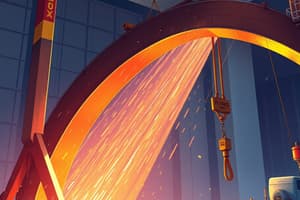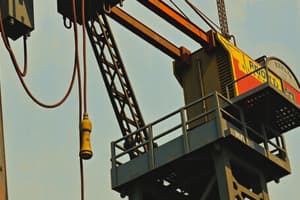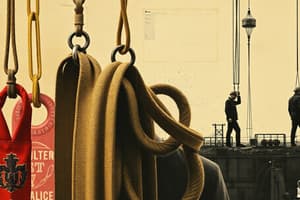Podcast
Questions and Answers
What is one advantage of aluminium compared to steel?
What is one advantage of aluminium compared to steel?
- It is more brittle
- It is heavier
- It has better corrosion resistance (correct)
- It is more susceptible to corrosion
What is a typical use of aluminium mentioned in the text?
What is a typical use of aluminium mentioned in the text?
- Welding equipment
- Ferrules for wire rope eyes (correct)
- Concrete reinforcement bars
- Bolts for heavy machinery
What can the presence of impurities or additional elements in alloy steel lead to?
What can the presence of impurities or additional elements in alloy steel lead to?
- Better corrosion resistance
- Strain age embrittlement (correct)
- Increased flexibility
- Reduced strength
What can oxides in finished steel produce, according to the text?
What can oxides in finished steel produce, according to the text?
What does 'killed steel' refer to in the text?
What does 'killed steel' refer to in the text?
Which element added to steel attracts oxygen and helps de-oxidise it?
Which element added to steel attracts oxygen and helps de-oxidise it?
What is the traditional form of textile sling whose origins are recorded in the earliest history of lifting equipment?
What is the traditional form of textile sling whose origins are recorded in the earliest history of lifting equipment?
Which of the following natural fibres is NOT commonly used for rope slings?
Which of the following natural fibres is NOT commonly used for rope slings?
What is the purpose of heat treatment on a piece of steel that has been worked?
What is the purpose of heat treatment on a piece of steel that has been worked?
What is the definition of heat treatment?
What is the definition of heat treatment?
Which of the following is NOT a reason why the use of fibre rope slings has declined in recent years?
Which of the following is NOT a reason why the use of fibre rope slings has declined in recent years?
How are fibre rope slings typically produced?
How are fibre rope slings typically produced?
Which property describes a material's ability to resist being pulled apart?
Which property describes a material's ability to resist being pulled apart?
What property is the opposite of brittleness?
What property is the opposite of brittleness?
Which property describes a material's ability to deform under compressive stress?
Which property describes a material's ability to deform under compressive stress?
Which property is essential for materials used in lifting equipment to resist shock loads?
Which property is essential for materials used in lifting equipment to resist shock loads?
What property is important for materials used in components that experience wear?
What property is important for materials used in components that experience wear?
Which of the following is NOT a desirable property for materials used in lifting equipment manufacturing?
Which of the following is NOT a desirable property for materials used in lifting equipment manufacturing?
What is the typical carbon content range for higher tensile steel?
What is the typical carbon content range for higher tensile steel?
Which type of steel is considered unsuitable for use in the manufacture of lifting gear?
Which type of steel is considered unsuitable for use in the manufacture of lifting gear?
What is the key difference between mild steel and higher tensile steel?
What is the key difference between mild steel and higher tensile steel?
What is the typical use of high tensile steel in lifting equipment?
What is the typical use of high tensile steel in lifting equipment?
How can you identify mild steel?
How can you identify mild steel?
What is the purpose of adding other elements to steel?
What is the purpose of adding other elements to steel?
What is the primary purpose of alloying steel with other metals?
What is the primary purpose of alloying steel with other metals?
Which of the following statements about alloys is true?
Which of the following statements about alloys is true?
Which of the following alloys is primarily used for its electrical conductivity?
Which of the following alloys is primarily used for its electrical conductivity?
What is the primary advantage of using Monel Metal in certain applications?
What is the primary advantage of using Monel Metal in certain applications?
Which of the following alloys is made by combining copper and tin?
Which of the following alloys is made by combining copper and tin?
What is the primary disadvantage of using Monel Metal in certain applications?
What is the primary disadvantage of using Monel Metal in certain applications?
Flashcards are hidden until you start studying
Study Notes
Steel and Aluminium Comparison
- One advantage of aluminium compared to steel is its unique properties.
Steel Properties and Uses
- Alloy steel with impurities or additional elements can lead to changes in its properties.
- Oxides in finished steel can produce scale or rust.
- 'Killed steel' refers to steel that has been de-oxidised to remove oxygen.
- Aluminium is added to steel to attract oxygen and help de-oxidise it.
- Heat treatment is used to relieve internal stresses in a piece of steel that has been worked.
- Heat treatment is defined as a process involving heating and cooling to achieve desired properties.
Textile Slings
- The traditional form of textile sling is the rope sling, with origins recorded in the earliest history of lifting equipment.
- Sisal is not commonly used for rope slings.
- Fibre rope slings are typically produced by braiding or twisting natural fibres.
- The property of tenacity describes a material's ability to resist being pulled apart.
- Ductility is the opposite of brittleness.
- Compressibility describes a material's ability to deform under compressive stress.
- Toughness is essential for materials used in lifting equipment to resist shock loads.
- Hardness is important for materials used in components that experience wear.
- Brittleness is not a desirable property for materials used in lifting equipment manufacturing.
Steel Types and Properties
- Higher tensile steel has a typical carbon content range of 0.5-1.5%.
- Mild steel is considered unsuitable for use in the manufacture of lifting gear.
- The key difference between mild steel and higher tensile steel is the carbon content.
- High tensile steel is typically used in lifting equipment for its strength and durability.
- Mild steel can be identified by its lower carbon content and lower strength.
- Adding other elements to steel can alter its properties and make it more suitable for specific applications.
- The primary purpose of alloying steel with other metals is to enhance its properties.
- Alloys are true metals with a combination of elements.
- Cupronickel is primarily used for its electrical conductivity.
- Monel Metal has the primary advantage of being corrosion-resistant.
- Bronze is made by combining copper and tin.
- The primary disadvantage of using Monel Metal in certain applications is its high cost.
Studying That Suits You
Use AI to generate personalized quizzes and flashcards to suit your learning preferences.




